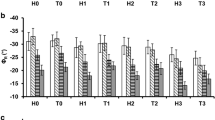Abstract
Two methods for measuring proton fluxes along intact maize roots grown with NH +4 or NO −3 at pH 6.5 were compared. Videodensitometric measurement of changes in a pH-indicator dye by video camera was used to map pH around roots and determine the amounts of protons released by various root regions. This method was compared with potentiometric determination of the concentration of H+ in the unstirred layer at the root surface using ion-selective microelectrodes. With NH +4 the roots released large amounts of H+ in preferential regions where the rate of flux can reach 1.4 or even 2.5 nmol m−1 s−1. Videodensitometry indicated a first region of root acidification in the subapical zone, but this was more difficult to localize with microelectrodes. With NO3 − both methods showed that the roots released small amounts of H+ and that the apical region took up H+ in the first 10 mm then sometimes released H+ over the following 10 mm of root. The H+ flux profiles obtained by both methods were in good agreement in terms of both order of magnitude of the fluxes and spatial differences along the root. These results suggest that videodensitometry, which is easier to use than potentiometry, can be used to screen different plant species or cultivars under various experimental conditions. The microelectrode technique is indispensable, however, for studying the underlying mechanisms of net H+ fluxes.
Similar content being viewed by others
References
Allen C R and Allen S 1987a The titrimetric assay of H+ excreted by Ricinus communis cultivated on NH +4 –N nutrient media: the effect of ionic strength and nutrient phosphate concentration. J. Exp. Bot. 38, 597–606.
Allen C R and Allen S 1987b The titrimetric assay of OH_ and HCO _3 excreted by Ricinus cultivated on NO _3 -containing nutrient media: the influence of ionic strength, end point pH and CO2 supersaturation. J. Exp. Bot. 38, 607–617.
Bloom A J 1997Interactions between inorganic nitrogen nutrition and root development. Z. Pflanzenernähr. Bodenkd. 160, 253–259.
Calba H and Jaillard B 1997Effect of aluminium on ion uptake and H+ release by maize. New Phytol. 137, 607–616.
Calba H, Jaillard B, Fallavier P and Arvieu J C 1995Agarose as a suitable substrate for use in the study of Al dynamics in the rhizosphere. Plant Soil 178, 67–74.
Dinkelaker B, Hahn G, Römheld V, Wolf G A and Marschner H 1994Non-destructive methods for demonstrating chemical changes in the rhizosphere I. Description of methods. Plant Soil 155/156, 71–74.
Gollany H T and Schumacher T E 1993Combined use of colorimetric and microelectrode methods for evaluating rhizosphere pH. Plant Soil 154, 151–159.
Haynes R J 1990Active ion uptake and maintenance of cationanion balance: a critical examination of their role in regulating rhizosphere pH. Plant Soil 126, 247–264.
Henriksen G H, Bloom A J and Spanswick R M 1990Measurement of net fluxes of ammonium and nitrate at the surface of barley roots using ion-selective microelectrodes. Plant Physiol. 39, 196–203.
Henriksen G H, Raman D R, Walker L P and Spanswick R M 1992Measurement of net fluxes of ammonium and nitrate at the surface of barley roots using ion-selective microelectrodes. II. Patterns of uptake along the root axis and evaluation of the microelectrode flux estimation technique. Plant Physiol. 99, 734–747.
Jaillard B, Ruiz L, Arvieu J C 1996pH mapping in transparent gel using color indicator videodensitometry. Plant Soil 183, 1–11.
Kochian L V, Shaff J E and Lucas W J 1989High affinity K+ uptake of maize roots: a lack of coupling with H+ efflux. Plant Physiol. 91, 1202–1211.
Kochian L V, Shaff J E, Kühtreiber W M, Jaffe L F and Lucas W J 1992Use of an extracellular, ion-selective, vibrating microelectrode system for the quantification of K+, H+, and Ca2+ fluxes in maize roots and maize suspension cells. Planta 188, 601–610.
Marschner H and Römheld V 1983In vivo measurement of rootinduced pH changes at the soil-root interface: effect of plant species and nitrogen source. Z. Pflanzenernähr. Bodenkd. 111, 241–251.
Marschner H, Römheld V, Horst W J and Martin P 1986Rootinduced changes in the rhizosphere: importance for the mineral nutrition of plants. Z. Pflanzenernähr. Bodenkd. 149, 441–456.
Mulkey T J and Evans M L 1981Geotropism in corn roots: evidence for its mediation by differential acid efflux. Science 212, 70–71.
Newman I A, Kochian L V, Grusak M A and Lucas W J 1987 Fluxes of HC and KC in corn roots: characterization and stochiometries using ion-selective microelectrodes. Plant Physiol. 84, 1177–1184.
O'Neill R A and Scott T K 1983Proton flux and elongation in primary roots of barley (Hordeum vulgare L.). Plant Physiol. 73, 199–201.
Ruiz L and Arvieu J C 1990Measurement of pH gradients in the rhizosphere. Symbiosis 9, 71–75.
Ryan P R, Newman I A and Shields B 1990Ion fluxes in corn roots measured by microelectrodes with ion-specific liquid membranes. J. Membr. Sci. 53, 59–69.
Weisenseel M H, Dorn A and Jaffe F J 1979Natural HC currents traverse growing roots and root hairs of barley (Hordeum vulgare L.). Plant Physiol. 64, 512–518.
Author information
Authors and Affiliations
Rights and permissions
About this article
Cite this article
Plassard, C., Meslem, M. & Souche, G. Localization and quantification of net fluxes of H+ along maize roots by combined use of pH-indicator dye videodensitometry and H+-selective microelectrodes. Plant and Soil 211, 29–39 (1999). https://doi.org/10.1023/A:1004560208777
Issue Date:
DOI: https://doi.org/10.1023/A:1004560208777




